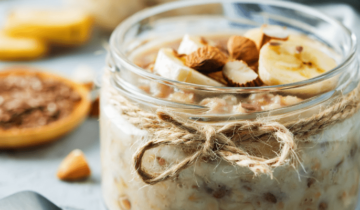Bone Health During Menopause may not be at the forefront of anyone’s mind when it comes to their menopause journey but here we go into more detail about how you can navigate this during your menopausal journey.
Nutritionist Emma Bardwell talks us through the importance of nutrition and calcium for maintaining bone health during menopause
Bone Health During Menopause
Menopause is a natural physiological event that happens to all women. While this stage of life brings with it many positives – from the end of periods to an increased sense of freedom – it’s unfortunately linked to some long term health concerns, one of which is the impact it has on bone health.
Oestrogen has a protective effect on bones, so when hormone levels start to drop around perimenopause – the time leading up to menopause – it puts women at an increased risk of ‘silent’ conditions like osteoporosis (thinning, brittle bones) and its precursor, osteopenia. Osteoporosis increases the risk of ‘fragility fractures’ occurring, even with little or no trauma. This means normal stresses on your bones – from sitting, standing, coughing or even hugging – can result in painful fractures.
Around the time of menopause, bone loss can be as much as 6-10 percent. Post menopause, the rate of loss drops to a steady 0.5-1 percent a year. It is, therefore, critical we focus on factors that can mitigate this decline.
Nutrition and lifestyle both play a crucial role in preserving bone density and reducing the risk of osteoporosis. As always, prevention is better than cure. So let’s look in more detail at ways to keep your bones healthy and strong.
Spotlight on calcium
Calcium is an essential mineral that helps maintain bone structure and strength, as well as healthy muscle and nerve function. During perimenopause, when oestrogen levels start to decline, the body’s ability to absorb and retain calcium decreases.
A study published in the Journal of Bone and Mineral Research examined the impact of calcium intake on bone health in postmenopausal women. The researchers found that higher calcium intake was associated with greater bone mineral density, which in turn correlated with reduced fracture risk (Rizzoli et al., 2014).
For most adults over the age of 18, the UK recommendation is 700mg of calcium a day, which increases to 1200mg when post menopausal. Women with coeliac disease or inflammatory bowel disease have a daily requirement of around 1000mg. To find out whether you’re close to achieving your target or not, try using an online calcium calculator such as this one.

Dairy is the most frequently cited source of calcium, but it’s certainly not the only source. Thankfully, these days, there are plenty of animal and plant based options to choose from, including:
- Fish with small bones such as sardines, pilchards and whitebait
- Calcium set tofu and calcium-fortified foods such as plant milk (check labels)
- *Menoligna provides 354mg of calcium, which is just over half a woman aged under 50’s daily requirement.
- Leafy greens, such as rocket, kale, watercress, bok choi, broccoli and spring greens
- Beans and lentils, especially butter beans, edamame beans and chickpeas
- Nuts and seeds, including tahini and nut butter
- Oranges, dried figs and apricots
Note: you may have heard about oxalates in certain foods, such as spinach, that can bind to calcium and prevent absorption. The key is to gently steam these foods, which dramatically reduces their oxalate content. Using sprouted grains, beans and legumes can also help upregulate the bioavailability of calcium. It’s worth noting here that Linwoods use sprouted, milled flaxseed and quinoa in their *Menoligna product which helps maximise the goodness that your body can extract from these tiny seeds.
Beware of calcium ‘thieves’
Some ingredients have been shown to leech bones of calcium. They include smoking, fizzy drinks, high caffeine (in people whose calcium levels are already low), alcohol, excess salt and certain medications such as steroids, anticonvulsants, some anti-depressants, PPIs, lithium, chemotherapy and aromatase inhibitors.
In addition, there are certain medical conditions which can also impact the health of bones. These include:
- Arthritis
- Type 2 diabetes
- Cushing’s syndrome
- Low BMI
- Overactive thyroid
- Early menopause
- Inflammatory bowel disorder
- Coeliac disease
Vitamin D and Magnesium
Vitamin D and magnesium are essential partners in calcium metabolism. Vitamin D facilitates the absorption of calcium from food, while magnesium contributes to bone structure and strength.
Our main source of vitamin D is sunlight. Food sources of adequate vitamin D are hard to find, so supplementation is often advised, especially in the UK where it can be hard to get enough exposure to sun to synthesise vitamin D.
A study in the Journal of Bone and Mineral Research investigated the combined effects of calcium and vitamin D supplementation on bone health in postmenopausal women. The researchers found that the combination of these two micronutrients significantly improved bone mineral density and reduced the risk of fractures (Jackson et al. 2006). Similarly, a study published in the European Journal of Epidemiology highlighted the positive relationship between magnesium intake and bone health in postmenopausal women (Orchard et al. 2014).
Fortified foods, such as *Menoligna, which contains marine calcium and magnesium, together with vitamin D3 and vitamin K2, to help absorption, can be a brilliant – not to mention time saving and great tasting – addition to menopausal women’s diets.
Protein: the building block of bones
Protein is another key component of bones, providing the structural framework necessary for maintaining bone strength. Ageing and menopause can lead to an increased risk of muscle loss, known as sarcopenia, and decreased muscle protein synthesis, which makes it harder to build muscle. These two factors can have a knock-on negative impact.
Research published in the American Journal of Clinical Nutrition investigated the effects of dietary protein on bone health in postmenopausal women. The study demonstrated that higher protein intake was associated with greater bone mineral density and a reduced risk of fractures (Shams-White et al. 2018).
So, what does this look like in day to day life? As a rough guide, aim to include a palm size portion or about 20-30g of protein (ie a medium chicken breast or half a block of tofu) with each meal.
Good sources include:
- Lean meats
- Fish
- Dairy
- Eggs
- Soya based products
- Seitan
- Tempeh
- Edamame beans
- Legumes
Top tip: Try adding two tablespoons of Menoligna to150g of Greek or soya yoghurt together with a splash of soya milk, a tablespoon of chia seeds, a few berries and a sprinkle of cinnamon for a great tasting, high protein (>25g) breakfast.
Movement
Bone is a living tissue that grows stronger in reaction to increases in loads and forces, so regular exercise is essential (Manaye et al. 2023). It is important to find a type of movement that you enjoy to ensure you do it consistently. Sports such as running, walking, yoga, tennis and dance not only keep you fit and healthy, they can also help keep your bones strong.
Weight bearing exercise on two or more days a week – even carrying shopping bags counts – is crucial for maintaining and building bone and can be part of the recommended 150 minute weekly target. Not sure what counts as weight bearing? If your feet touch the ground during an exercise, it probably fits the bill. So, jogging and boxing are excellent choices, cycling or swimming not so much.

Conclusion
• Nutrition plays a pivotal role in maintaining bone health throughout a woman’s life, but it becomes even more essential during menopause.
• Several key nutrients work synergistically to contribute to bone strength. Linwood’s *Menoligna includes the main players, including calcium, vitamin D, protein, magnesium and vitamin K – all neatly packaged in one, easy-to-use product.
• Stay active (150 minutes of moderate intensity or 75 of vigorous intensity a week) and avoid sitting for long periods
• Make sure you’re meeting your energy intake requirements. Eating disorders where diet is restricted can be a cause for periods to stop and this in turn can lead to weakened bones
• Smoking and alcohol are both linked to increased risk of osteoporosis
Linwoods have made life easier for menopausal women by creating a powdered blend, Menoligna, that has been specially developed with this important life stage in mind. Each 30g Menoligna serving provides 300mg of lignans, which are a prime source of phytoestrogens, as well as key nutrients that can help manage menopause symptoms and maintain ongoing health. These include CoQ10, protein, calcium, iron, magnesium, as well as vitamins D3, K2, B1, B2, B3, B5, B6 and B12.
References:
For this article on Bone Health During Menopause the following articles were used.
Rizzoli et al. (2014). Nutrition and bone health in women after the menopause.
Jackson et al. (2006). Calcium plus vitamin D supplemental and the risk of fractures.
Orchard et al. (2014). Magnesium intake, bone mineral density, and fractures.
Shams-White et al. (2018). Dietary protein and bone health: a systematic review and meta analysis.
Manaye et al. (2023). The role of high intensity and high impact exercises in improving bone health in post menopausal women: a systematic review.
About The Author

Emma Bardwell is a registered nutritionist, author and writer. Her evidence based, no-nonsense approach has made her one of the go-to names in women’s health and nutrition. She combines leading edge research with a 360 degree focus on diet and lifestyle to help optimise wellbeing. She regularly contributes to publications such as Red Magazine, Vogue, The Telegraph and Sheerluxe, and is co-author of best selling book, The Perimenopause Solution.
If you enjoyed this article on bone health during menopause be sure to check out our blog in which Emma is a frequent contributor.







 No products in the cart.
No products in the cart.